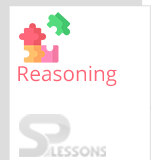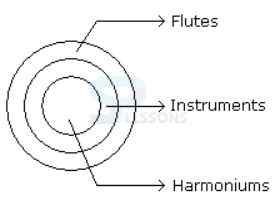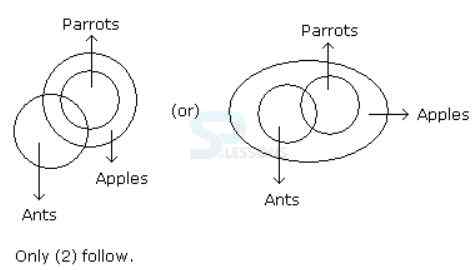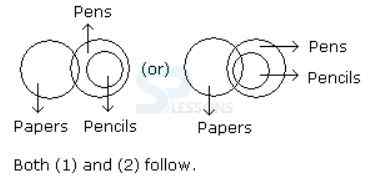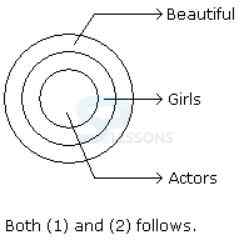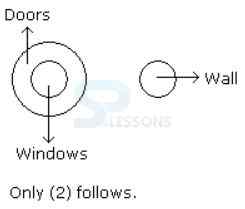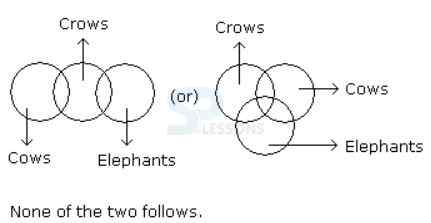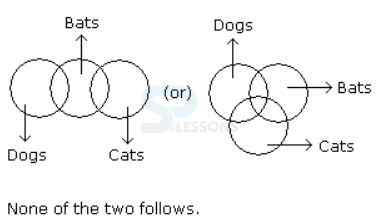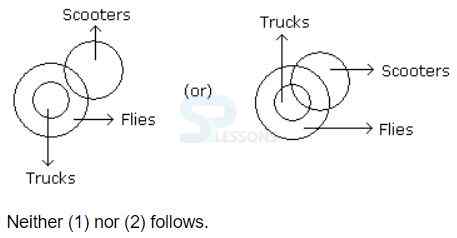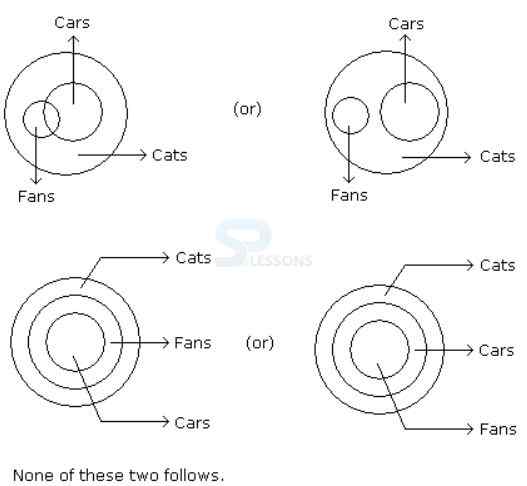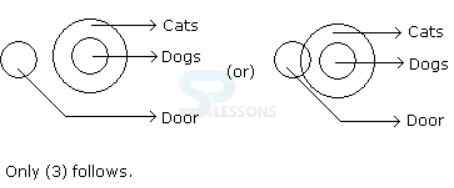 Introduction
Introduction
What is a Syllogism? A syllogism is a deductive argument relating two premises and a conclusion, all of which are quantified propositions, i.e. propositions joining concepts by using words such as 'some' and 'all'. In simple terms, Syllogism is a deductive argument that is primarily composed of 3 propositions. One of the propositions is used as the conclusion of the syllogism and the other two propositions are used as the premises of the syllogism. Deductive Logic is used to derive conclusions from premises where the truth of the conclusion must always be contained in the truth of the premises. Syllogism Practice Quiz 2 presents Syllogism questions with solutions useful for candidates preparing for different competitive examinations like RRB ALP/Technical Exams/Junior Engineer Recruitment Exams, SSC CGL,SSC CHSL, IBPS, SBI PO, SBI Clerks, CAT and etc.
Syllogism is derived from the Greek word syllogismos, meaning conclusion or inference. Some syllogisms contain three components:
Major Premise
Minor Premise
Conclusion
Example: All roses are flowers (major premise). This is a rose (minor premise). Therefore, I am holding a flower (conclusion).
 Quiz
Quiz
Direction (1 - 5): In each of the following questions two statements are given and these statements are followed by two conclusions numbered (I) and (II). You have to take the given two statements to be true even if they seem to be at variance from commonly known facts. Read the conclusions and then decide which of the given conclusions logically follows from the two given statements, disregarding commonly known facts.
Give answer:
(A) If only (1) conclusion follows
(B) If only (2) conclusion follows
(C) If either (1) or (2) follows
(D) If neither (1) nor (2) follows and
(E) If both (1) and (2) follow.
1. Statements:
Some actors are singers. All the singers are dancers.
Conclusions:
1. Some actors are dancers.
2. No singer is actor.
- A. Only (1) conclusion follows
B. Only (2) conclusion follows
C. Either (1) or (2) follows
D. Neither (1) nor (2) follows
E. If both (1) and (2) follow
- A. Only (1) conclusion follows
B. Only (2) conclusion follows
C. Either (1) or (2) follows
D. Neither (1) nor (2) follows
E. If both (1) and (2) follow
- A. Only (1) conclusion follows
B. Only (2) conclusion follows
C. Either (1) or (2) follows
D. Neither (1) nor (2) follows
E. If both (1) and (2) follow
- A. Only (1) conclusion follows
B. Only (2) conclusion follows
C. Either (1) or (2) follows
D. Neither (1) nor (2) follows
E. If both (1) and (2) follow
- A. Only (1) conclusion follows
B. Only (2) conclusion follows
C. Neither (1) nor (2) follows
D. Both (1) and (2) follow
E. If both (1) and (2) follow
Direction (1 - 5): In each of the following questions two statements are given and these statements are followed by two conclusions numbered (I) and (II). You have to take the given two statements to be true even if they seem to be at variance from commonly known facts. Read the conclusions and then decide which of the given conclusions logically follows from the two given statements, disregarding commonly known facts.
Give answer:
(A) If only (1) conclusion follows
(B) If only (2) conclusion follows
(C) If either (1) or (2) follows
(D) If neither (1) nor (2) follows and
(E) If both (1) and (2) follow.
1. Statements:
All the actors are girls. All the girls are beautiful.
Conclusions:
1. All the actors are beautiful.
2. Some girls are actors.
- A. Only (1) conclusion follows
B. Only (2) conclusion follows
C. Either (1) or (2) follows
D. Both (1) and (2) follow
E. If both (1) and (2) follow
- A. Only (1) conclusion follows
B. Only (2) conclusion follows
C. Either (1) or (2) follows
D. Neither (1) nor (2) follows
E. If both (1) and (2) follow
- A. Only (1) conclusion follows
B. Only (2) conclusion follows
C. Either (1) or (2) follows
D. Neither (1) nor (2) follows
E. If both (1) and (2) follow
- A. Only (1) conclusion follows
B. Only (2) conclusion follows
C. Either (1) or (2) follows
D. Neither (1) nor (2) follows
E. If both (1) and (2) follow
- A. Only (1) conclusion follows
B. Only (2) conclusion follows
C. Either (1) or (2) follows
D. Both (1) and (2) follow
E. If both (1) and (2) follow
Direction (1 - 4): In each of the following questions two statements are given and these statements are followed by two conclusions numbered (I) and (II). You have to take the given two statements to be true even if they seem to be at variance from commonly known facts. Read the conclusions and then decide which of the given conclusions logically follows from the two given statements, disregarding commonly known facts.
Give answer:
(A) If only (1) conclusion follows
(B) If only (2) conclusion follows
(C) If either (1) or (2) follows
(D) If neither (1) nor (2) follows and
(E) If both (1) and (2) follow.
1. Statements: Some dogs are bats. Some bats are cats.
Conclusions:
1. Some dogs are cats.
2. Some cats are dogs.
- A. Only (1) conclusion follows
B. Only (2) conclusion follows
C. Either (1) or (2) follows
D. Neither (1) nor (2) follows
E. If both (1) and (2) follow
- A. Only (1) conclusion follows
B. Only (2) conclusion follows
C. Either (1) or (2) follows
D. Neither (1) nor (2) follows
E. If both (1) and (2) follow
- A. Only (1) conclusion follows
B. Only (2) conclusion follows
C. Either (1) or (2) follows
D. Neither (1) nor (2) follows
E. If both (1) and (2) follow
- A. Only (1) conclusion follows
B. Only (2) conclusion follows
C. Either (1) or (2) follows
D. Neither (1) nor (2) follows
E. If both (1) and (2) follow
- A. Only (2) and (4)
B. Only (1) and (3)
C. Only (3) and (4)
D. Only (3)
E. If both (1) and (2) follow
Other Articles
 Study Guide
Study Guide
 Exams
Exams
| Competitive Exams - College Entrance Exams | |||
|---|---|---|---|
| Category | Notification | ||
| Diploma | NITC New Delhi | Goa Diploma Admissions 2019 | |
| Graduate | WBJEE JECA | ||
| Click Here For – All India Entrance Exam Notifications | |||
 Daily CA
Daily CA
 Job-Alerts
Job-Alerts
 SP Quiz
SP Quiz
| Competitive Exams - Practice Sets | |
|---|---|
| Category | Quiz |
| Quant Aptitude | Permutation and Combination |
| Reasoning Ability | Spotting Errors |
| Insurance Awareness | Insurance Awareness |
 GK
GK
| General Knowledge for Competitive Examinations | |
|---|---|
| Topic | Name of the Article |
| GK - World | North America Countries Capitals Currencies |
| Important Battles – World History | |
| GK - India | Indian Republic Day Chief Guests |
| Indian Railway Ministers | |
| GK - Abbreviations | Science Information Technology Abbreviations |
| International Organizations Abbreviations | |
| GK - Banking & Insurance | Banking Channels |
| Health Insurance In India | |
| GK - Science & Technology | Scientific Laws and Theories |
| Ama Ghare LED Scheme | |
